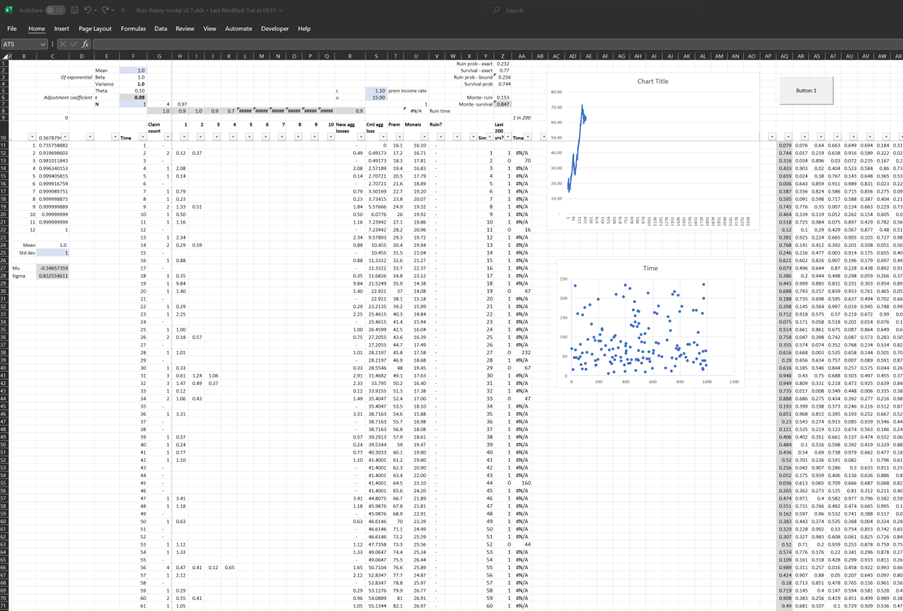|
I’ve had the textbook 'Modelling Extremal Events: For Insurance and Finance’ sat on my shelf for a while, and last week I finally got around to working through a couple of chapters. One thing I found interesting, just around how my own approach has developed over the years, is that even though it’s quite a maths heavy book my instinct was to immediately build some toy models and play around with the results. I recall earlier in my career, when I had just got out of a 4-year maths course, I was much more inclined to understand new topics via working through proofs step-by-step in long hand, pen to paper.
In case it’s of interest to others, I thought I’d upload my Excel version I built of the classic ruin process. In particular I was interested in how the Cramer-Lundberg theorem fails for sub-exponential distributions (which includes the very common Lognormal distribution). Therefore the Spreadsheet contains a comparison of this theorem against the correct answer, derived from monte carlo simulation. The Speadsheet can be found here: https://github.com/Lewis-Walsh/RuinTheoryModel The first tab uses an exponential distribution, and the second uses a Lognormal distribution. Screenshot below. I also coded a similar model in Python via Jupyter Notebook, which you can read about below. Here I have specifically used a LogN distribution, and I compare the ruin probability I derive using a monte carlo simulation, with the value from the Cramer-Lundberg theorem, to understand the extent to which it under-estimates the ruin probability.
In [1]:
import numpy as np
import time
import matplotlib.pyplot as plt
import math
In [2]:
# Set parameters
mean_poisson = 1
mean_lognormal = 1
std_dev_lognormal = 1.5
u = 15
c = 1.1
num_simulations = 10000
max_poisson_samples = 500
# Calculate parameters mu and sigma
mu = np.log(mean_lognormal**2 / np.sqrt(std_dev_lognormal**2 + mean_lognormal**2))
sigma = np.sqrt(np.log(1 + std_dev_lognormal**2 / mean_lognormal**2))
In [3]:
# Initialize arrays to record results
results = []
poisson_sims_before_stop = []
# Start timing for simulations
start_time_simulations = time.time()
for _ in range(num_simulations):
t = 0
S_t = 0
poisson_sims = 0
while t < max_poisson_samples:
poisson_sample = np.random.poisson(mean_poisson)
lognormal_samples = np.random.lognormal(mu, sigma, poisson_sample)
S_t += np.sum(lognormal_samples)
f_t = u + c*t - S_t
if f_t < 0:
results.append(1)
poisson_sims_before_stop.append(poisson_sims)
break
t += 1
poisson_sims += 1
if t == max_poisson_samples:
results.append(0)
poisson_sims_before_stop.append(poisson_sims)
In [4]:
# Filter out values less than max_poisson_samples (500)
filtered_poisson_sims = [sims for sims in poisson_sims_before_stop if sims < max_poisson_samples]
# Calculate average number of Poisson simulations before stopping
avg_poisson_sims = np.mean(filtered_poisson_sims)
#Calculate the ruin probability
ruin_prob = len(filtered_poisson_sims) / len(poisson_sims_before_stop)
# Calculate total execution time in minutes and seconds
end_time_total = time.time()
execution_time_total = end_time_total - start_time_simulations
minutes_total = int(execution_time_total // 60)
seconds_total = int(execution_time_total % 60)
In [5]:
print(f"Ruin probability - monte carlo")
print(ruin_prob)
print(f"Ruin probability - Cramer-Lundberg")
theta = c/(mean_poisson*mean_lognormal)-1
print(1/(1+theta)*math.exp((-1*theta*u)/(1+theta)))
# Create a histogram to visualize the distribution
plt.hist(filtered_poisson_sims, bins=30, density=True, alpha=0.6, color='g', edgecolor='black')
plt.xlabel('Number of Poisson simulations before stopping')
plt.ylabel('Frequency')
plt.title('Distribution of Poisson Simulations Before Stopping')
plt.show()
Ruin probability - monte carlo 0.3703 Ruin probability - Cramer-Lundberg 0.23248105446645487
In [ ]:
We see the output from the Monte Carlo and Cramer-Lundberg (CL) at the bottom. The monte carlo is our 'correct' value and gives us a 37% chance of ruin, whereas the CL method only thinks there is a 23% chance of ruin. So, by using the CL method, we'd be quite materially underestimating the risk of ruin. |
AuthorI work as an actuary and underwriter at a global reinsurer in London. Categories
All
Archives
April 2024
|

 RSS Feed
RSS Feed
Leave a Reply.